A New Study on the Temperature and Bias Dependence of the Kink Effects in S22 and h21 for the GaN HEMT Technology
Abstract
:1. Introduction
2. Kink Effect in S22
3. Kink Effects in h21
4. Conclusions
Author Contributions
Funding
Conflicts of Interest
References
- Lu, S.-S.; Meng, C.; Chen, T.-W.; Chen, H.-C. The origin of the kink phenomenon of transistor scattering parameter S22. IEEE Trans. Microw. Theory Tech. 2001, 49, 333–340. [Google Scholar] [CrossRef]
- Lu, S.-S.; Meng, C.; Chen, T.-W.; Chen, H.-C. A novel interpretation of transistor S-parameters by poles and zeros for RF IC circuit design. IEEE Trans. Microw. Theory Tech. 2001, 49, 406–409. [Google Scholar] [CrossRef]
- Lin, Y.-S.; Lu, S.-S. An analysis of the kink phenomenon of scattering parameter S22 in RF power mosfets for system-on-chip (SOC) applications. Microw. Opt. Technol. Lett. 2003, 36, 371–376. [Google Scholar] [CrossRef]
- Lin, Y.-S. Temperature dependence of the power gain and scattering parameters S11 and S22 of an RF nMOSFET with advanced RF-CMOS technology. Microw. Opt. Technol. Lett. 2005, 44, 180–185. [Google Scholar] [CrossRef]
- Crupi, G.; Avolio, G.; Raffo, A.; Barmuta, P.; Schreurs, D.M.M.-P.; Caddemi, A.; Vannini, G. Investigation on the thermal behavior for microwave GaN HEMTs. Solid-State Electron. 2011, 64, 28–33. [Google Scholar] [CrossRef]
- Crupi, G.; Raffo, A.; Caddemi, A.; Vannini, G. The kink phenomenon in the transistor S22: A systematic and numerical approach. IEEE Microw. Wirel. Comp. Lett. 2012, 22, 406–408. [Google Scholar] [CrossRef]
- Crupi, G.; Raffo, A.; Schreurs, D.M.M.-P.; Avolio, G.; Caddemi, A.; Vannini, G. A clear-cut understanding of the current-gain peak in HEMTs: Theory and experiments. Microw. Opt. Technol. Lett. 2012, 54, 2801–2806. [Google Scholar] [CrossRef]
- Crupi, G.; Raffo, A.; Schreurs, D.M.M.-P.; Avolio, G.; Caddemi, A.; Vannini, G. Identification of the intrinsic capacitive core for GaAs HEMTs by investigating the frequency behavior of the impedance parameters. Microw. Opt. Technol. Lett. 2013, 55, 1237–1240. [Google Scholar] [CrossRef]
- Crupi, G.; Raffo, A.; Marinković, Z.; Avolio, G.; Caddemi, A.; Marković, V.; Vannini, G.; Schreurs, D.M.M.-P. An extensive experimental analysis of the kink effects in S22 and h21 for a GaN HEMT. IEEE Trans. Microw. Theory Tech. 2014, 62, 513–520. [Google Scholar] [CrossRef]
- Ahsan, S.A.; Ghosh, S.; Khandelwal, S.; Chauhan, Y.S. Modeling of kink-effect in RF behaviour of GaN HEMTs using ASM-HEMT model. In Proceedings of the IEEE International Conference on Electron Devices and Solid-State Circuits, Hong Kong, China, 3–5 August 2016; pp. 426–429. [Google Scholar]
- Ahsan, S.A.; Ghosh, S.; Khandelwal, S.; Chauhan, Y.S. Pole-zero approach to analyze and model the kink in gain-frequency plot of GaN HEMTs. IEEE Microw. Wirel. Comp. Lett. 2017, 27, 266–268. [Google Scholar] [CrossRef]
- Crupi, G.; Raffo, A.; Vadalà, V.; Avolio, G.; Schreurs, D.M.M.-P.; Vannini, G.; Caddemi, A. Technology-independent analysis of the double current-gain peak in millimeter-wave FETs. IEEE Microw. Wirel. Comp. Lett. 2018, 28, 326–328. [Google Scholar] [CrossRef]
- Crupi, G.; Raffo, A.; Vadalà, V.; Vannini, G.; Caddemi, A. Current-gain in FETs beyond cut-off frequency. Microw. Opt. Technol. Lett. 2018, 60, 3019–3023. [Google Scholar] [CrossRef]
- Shohat, J.; Robertson, I.D.; Nightingale, S.J. Investigation of drain-line loss and the S22 kink effect in capacitively coupled distributed amplifiers. IEEE Trans. Microw. Theory Tech. 2005, 53, 3767–3773. [Google Scholar] [CrossRef]
- Gao, H.; Sun, X.; Hua, Y.; Zhang, X.; Wang, R.; Li, G.P. A composite transistor to suppress kink phenomenon in HBTs for broadband design. IEEE Electron. Device Lett. 2010, 31, 1113–1115. [Google Scholar] [CrossRef]
- Grinberg, A.A.; Luryi, S. Coherent transistor. IEEE Trans. Electron. Dev. 1993, 40, 1512–1522. [Google Scholar] [CrossRef]
- Luryi, S.; Xu, J.; Zaslavsky, A. Future Trends in Microelectronics Reflections on the Road to Nanotechnology; Kluwer Academic Publishers: Dordrecht, The Netherlands, 1996. [Google Scholar]
- Jorke, H.; Schafer, M. Resonance phase operation of bipolar transistors. In Proceedings of the IEEE Topical Meeting on Silicon Monolithic Integrated Circuits in RF Systems, Garmisch, Germany, 11 April 2003; pp. 26–28. [Google Scholar]
- Kasper, E.; Eberhardt, J.; Jorke, H.; Luy, J.-F.; Kibbel, H.; Dashiell, M.W.; Schmidt, O.G.; Stoffel, M. SiGe resonance phase transistor: Active transistor operation beyond the transit frequency fT. Solid State Electron. 2004, 48, 837–840. [Google Scholar] [CrossRef]
- Heim, S.; Wanner, R.; Stoffel, M.; Kasper, E. Resonance phase operation of a SiGe HBT. Mat. Sci. Semic. Proc. 2005, 8, 319–322. [Google Scholar] [CrossRef]
- Cressler, J.D. Silicon Heterostructure Devices; CRC Press, Taylor and Francis Group: Boca Raton, FL, USA, 2008. [Google Scholar]
- Trew, R.J. Wide bandgap semiconductor transistors for microwave power amplifiers. IEEE Microw. Mag. 2000, 1, 46–54. [Google Scholar] [CrossRef]
- Colantonio, P.; Giannini, F.; Giofrè, R.; Limiti, E.; Serino, A.; Peroni, M. AC-band high-efficiency second-harmonic-tuned hybrid power amplifier in GaN technology. IEEE Trans. Microw. Theory Tech. 2006, 54, 2713–2722. [Google Scholar] [CrossRef]
- Marinković, Z.; Crupi, G.; Caddemi, A.; Avolio, G.; Raffo, A.; Marković, V.; Vannini, G.; Schreurs, D.M.M.-P. Neural approach for temperature dependent modeling of GaN HEMTs. Int. J. Numer. Model. 2015, 28, 359–370. [Google Scholar] [CrossRef]
- Quaglia, R.; Camarchia, V.; Pirola, M.; Ghione, G. GaN Monolithic power amplifiers for microwave backhaul applications. Electronics 2016, 5, 25. [Google Scholar] [CrossRef]
- Alim, M.A.; Rezazadeh, A.A.; Gaquiere, C. Temperature effect on DC and equivalent circuit parameters of 0.15-μm gate length GaN/SiC HEMT for microwave applications. IEEE Trans. Microw. Theory Tech. 2016, 64, 3483–3491. [Google Scholar] [CrossRef]
- Jarndal, A.; Kouki, A. Efficient modeling of GaN HEMTs for linear and nonlinear circuits design. Int. J. Numer. Model. 2017, 30, e2100. [Google Scholar] [CrossRef]
- Wen, Z.; Xu, Y.; Wang, C.; Zhao, X.; Chen, Z.; Xu, R. A parameter extraction method for GaN HEMT empirical large-signal model including self-heating and trapping effects. Int. J. Numer. Model. 2017, 30, e2137. [Google Scholar] [CrossRef]
- Ramella, C.; Piacibello, A.; Quaglia, R.; Camarchia, V.; Pirola, M. High efficiency power amplifiers for modern mobile communications: The load-modulation approach. Electronics 2017, 6, 96. [Google Scholar] [CrossRef]
- Foundry Process Data Sheet. Ref.: 170112_DS GaN GH25 Process_7012, United Monolithic Semiconductors, Villebon-sur-Yvette, France. Available online: https://www.ums-gaas.com/wp-content/uploads/2017/05/PPH25X.pdf (accessed on 15 October 2018).
- Floriot, D.; Brunel, V.; Camiade, M.; Chang, C.; Lambert, B.; Ouarch-Provost, Z.; Blanck, H.; Grunenputt, J.; Hosch, M.; Jung, H.; Splettstober, J.; Meiners, U. GH25-10: New qualified power GaN HEMT process from technology to product overview. In Proceedings of the 9th European Microwave Integrated Circuits Conference, Rome, Italy, 6–7 October 2014; pp. 225–228. [Google Scholar]
- Camarchia, V.; Colantonio, P.; Giannini, F.; Giofrè, R.; Jiang, T.; Pirola, M. A design strategy for AM/PM compensation in GaN Doherty power amplifiers. IEEE Access 2017, 5, 22244–22251. [Google Scholar] [CrossRef]
- Gonzalez, G. Microwave Transistor Amplifiers Analysis and Design; Prentice-Hall: Upper Saddle River, NJ, USA, 1996. [Google Scholar]
- Crupi, G.; Schreurs, D.M.M.-P.; Caddemi, A. Effects of gate-length scaling on microwave MOSFET performance. Electronics 2017, 6, 62. [Google Scholar] [CrossRef]
- Dambrine, G.; Cappy, A.; Heliodore, F.; Playez, E. A new method for determining the FET small-signal equivalent circuit. IEEE Trans. Microw. Theory Tech. 1988, 36, 1151–1159. [Google Scholar] [CrossRef]
- Tayrani, R.; Gerber, J.E.; Daniel, T.; Pengelly, R.S.; Rhode, U.L. A new and reliable direct parasitic extraction method for MESFETs and HEMTs. In Proceedings of the 1993 23rd European Microwave Conference, Madrid, Spain, 6–10 September 1993; pp. 451–453. [Google Scholar]
- Jarndal, A.; Kompa, G. An accurate small-signal model for AlGaN-GaN HEMT suitable for scalable large-signal model construction. IEEE Microw. Wirel. Comp. Lett. 2006, 16, 333–335. [Google Scholar] [CrossRef]
- Crupi, G.; Caddemi, A.; Schreurs, D.M.M.-P.; Dambrine, G. The large world of FET small-signal equivalent circuits. Int. J. RF Microw. Comput.-Aided Eng. 2016, 26, 749–762. [Google Scholar] [CrossRef]
- Wen, Z.; Xu, Y.; Wang, C.; Zhao, X.; Xu, R. An efficient parameter extraction method for GaN HEMT small-signal equivalent circuit model. Int. J. Numer. Model. 2017, 30, e2127. [Google Scholar] [CrossRef]

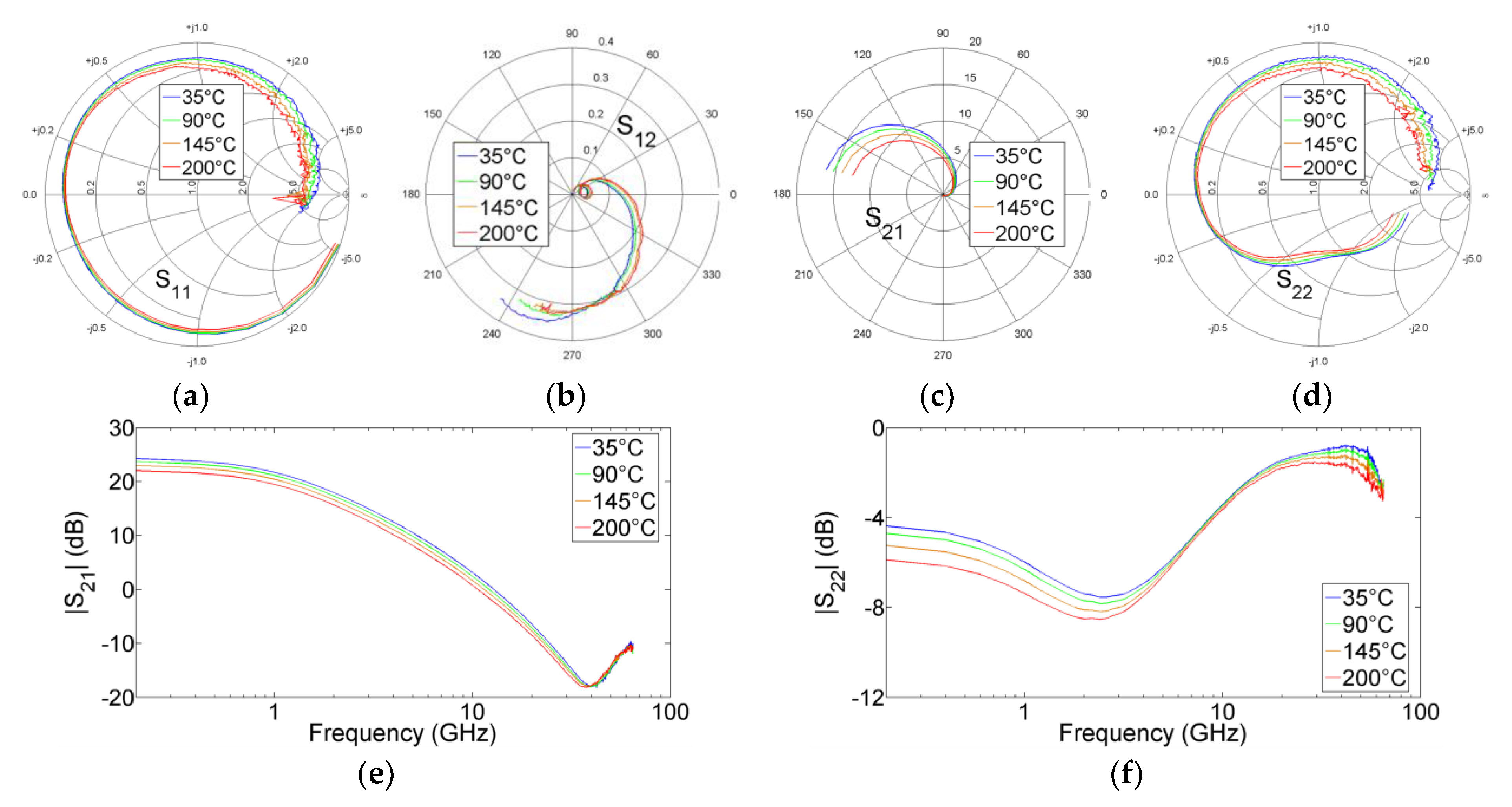
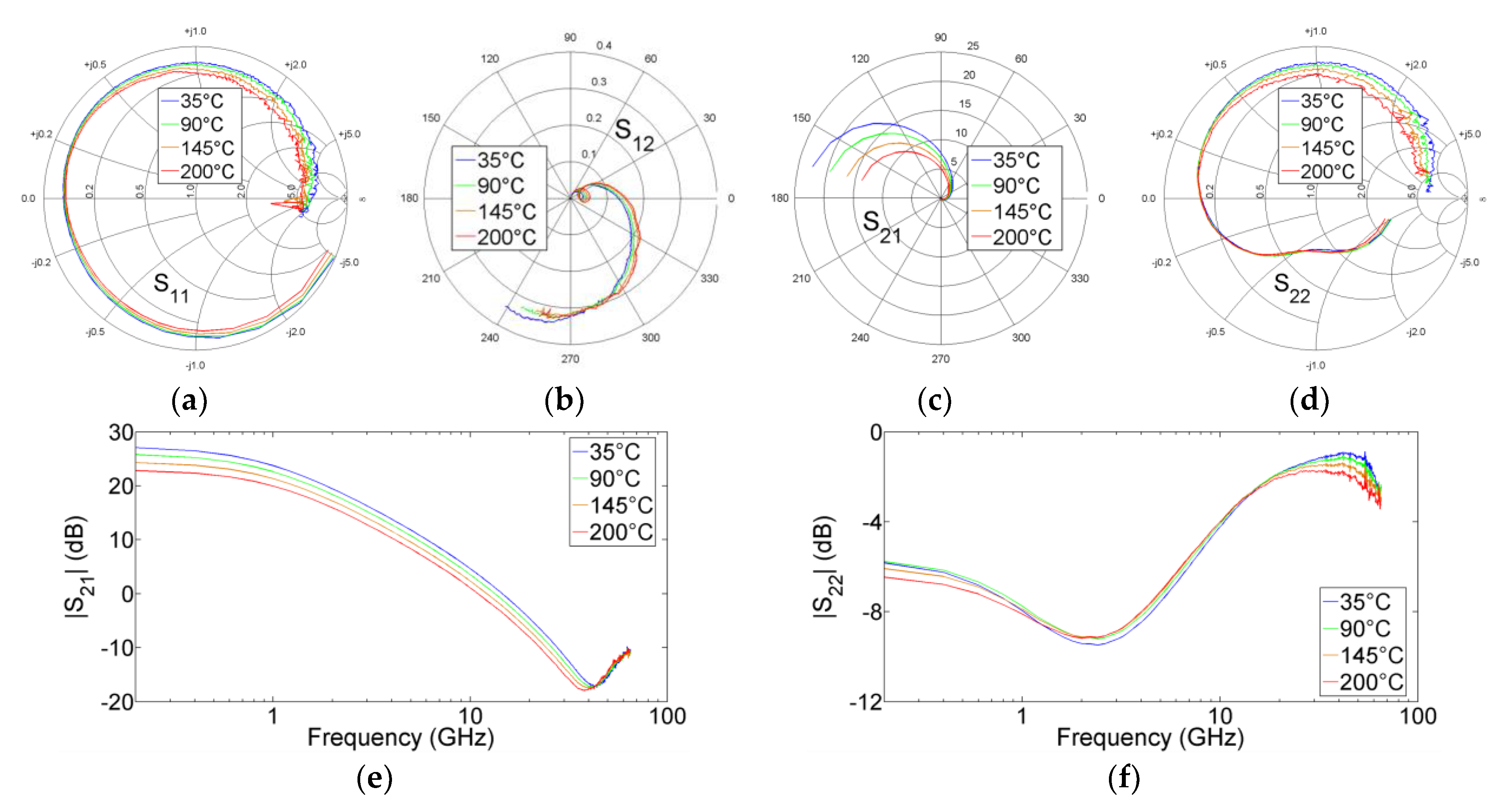


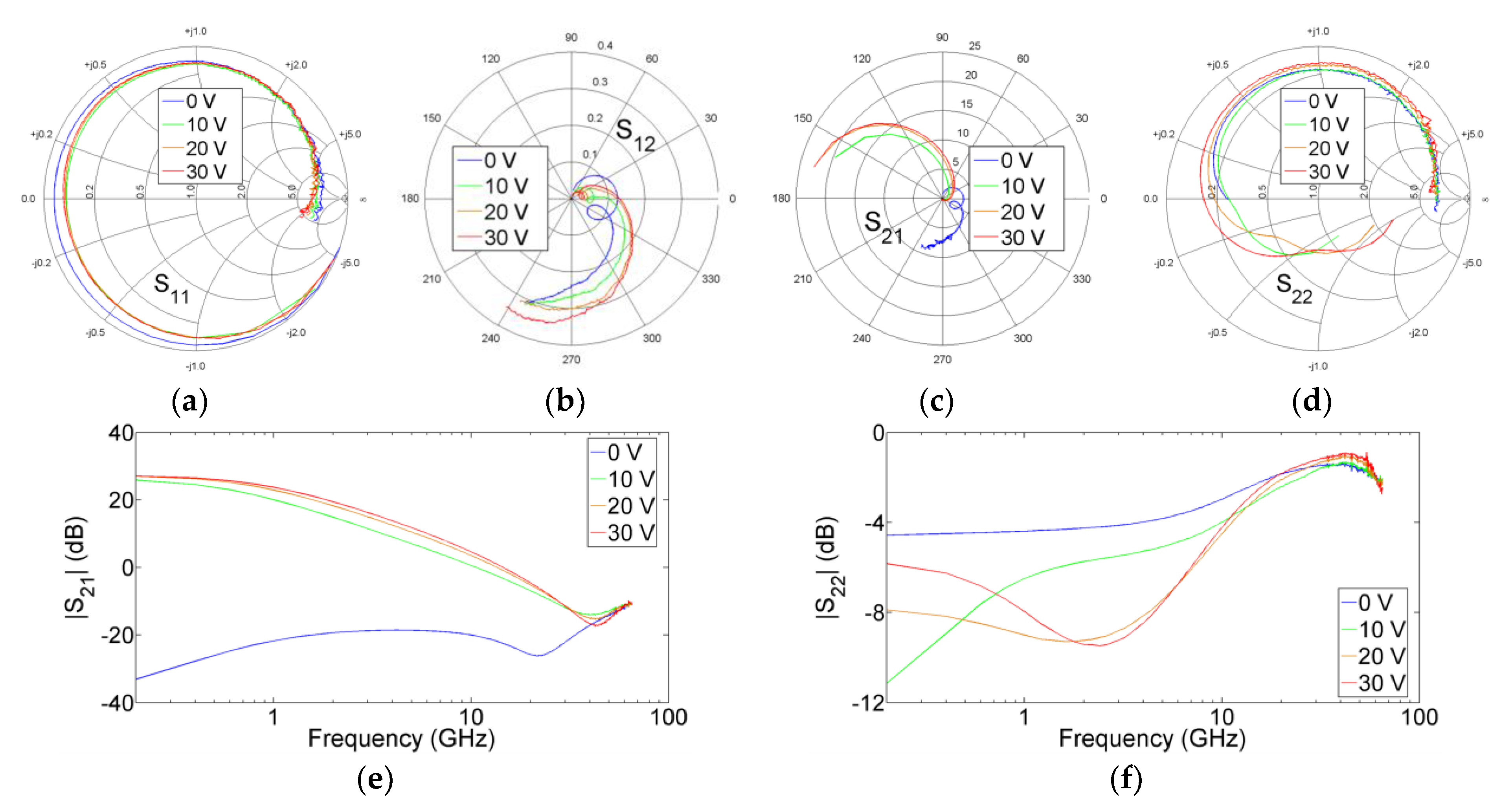
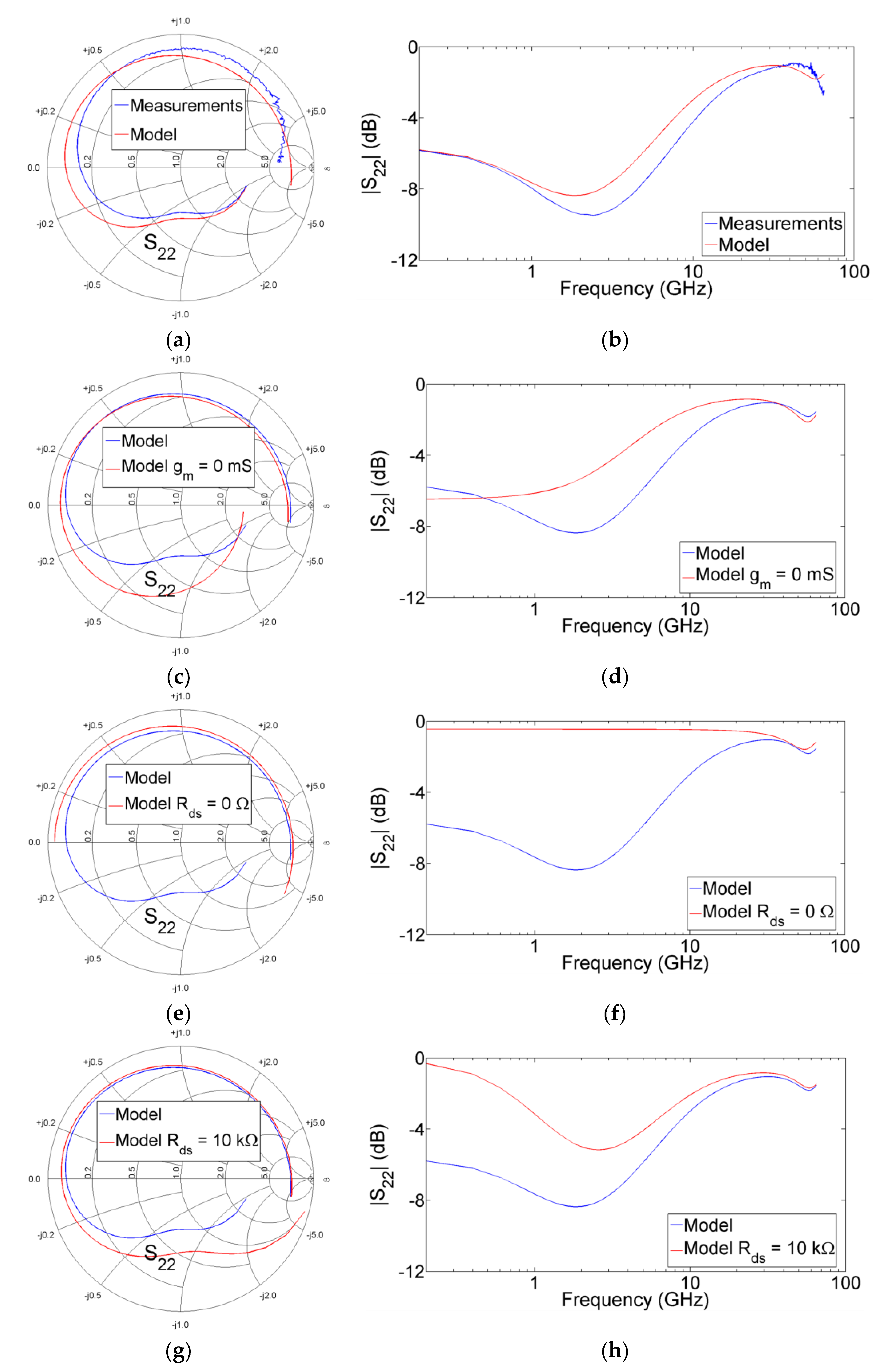

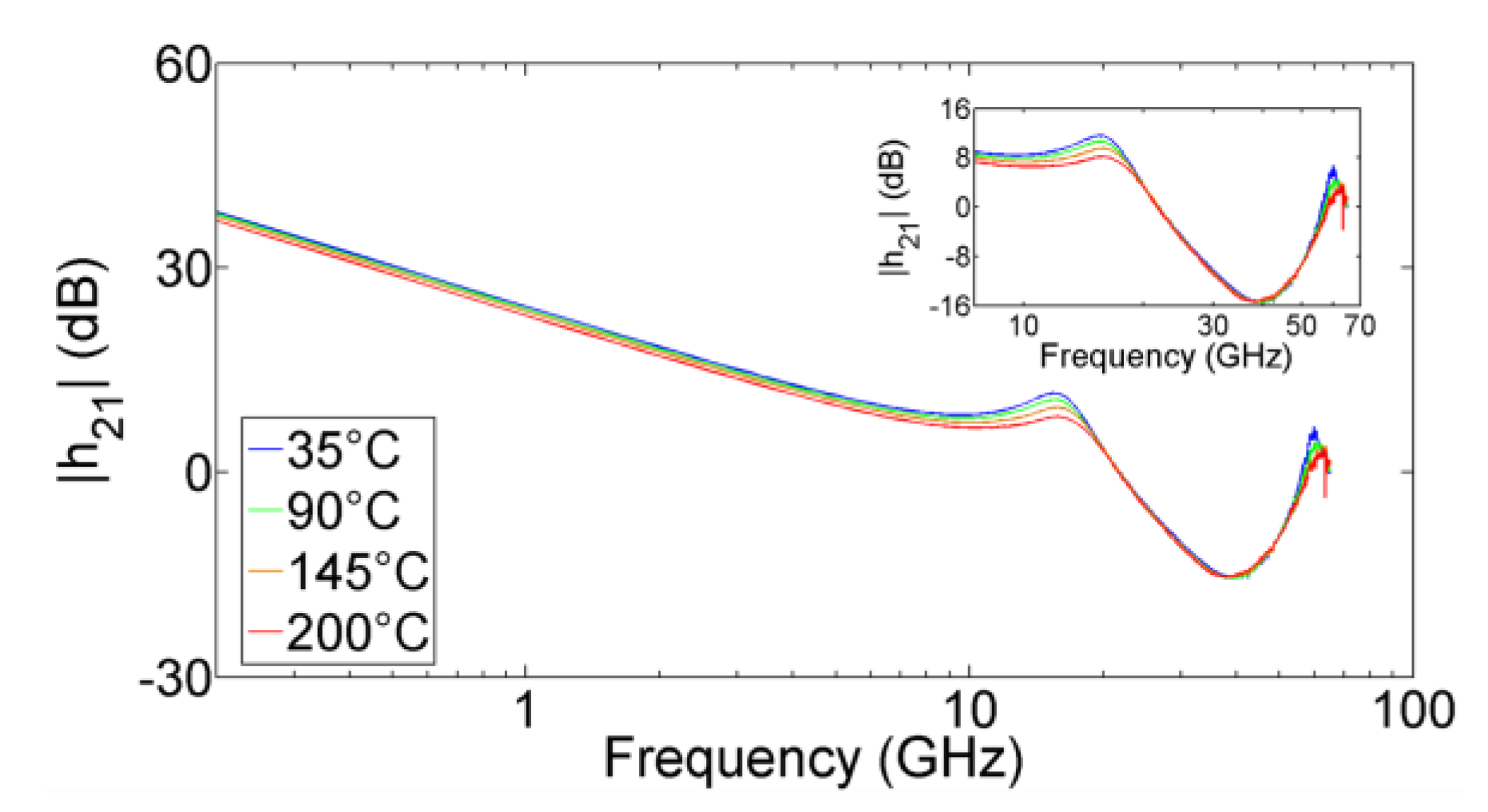
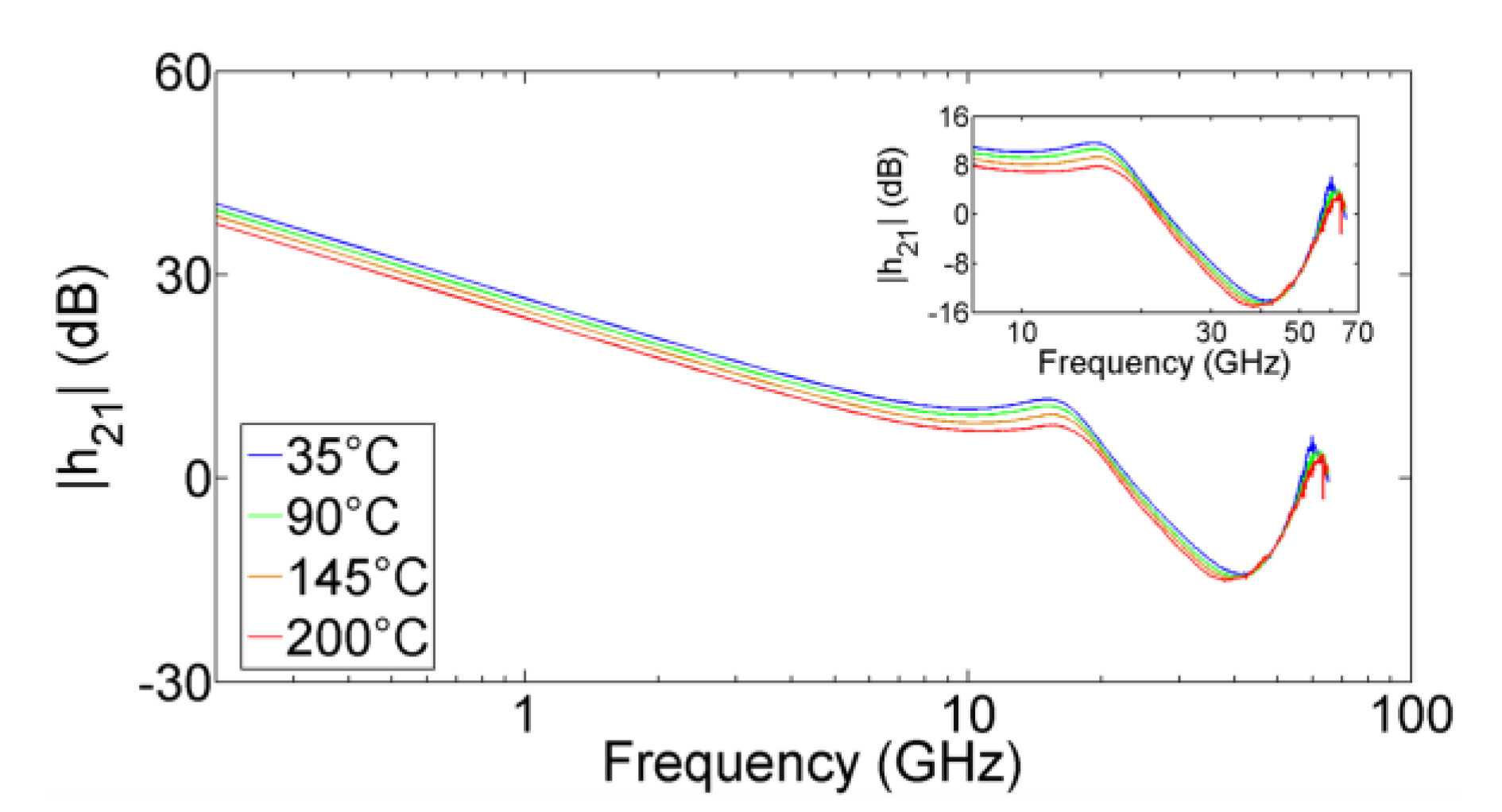
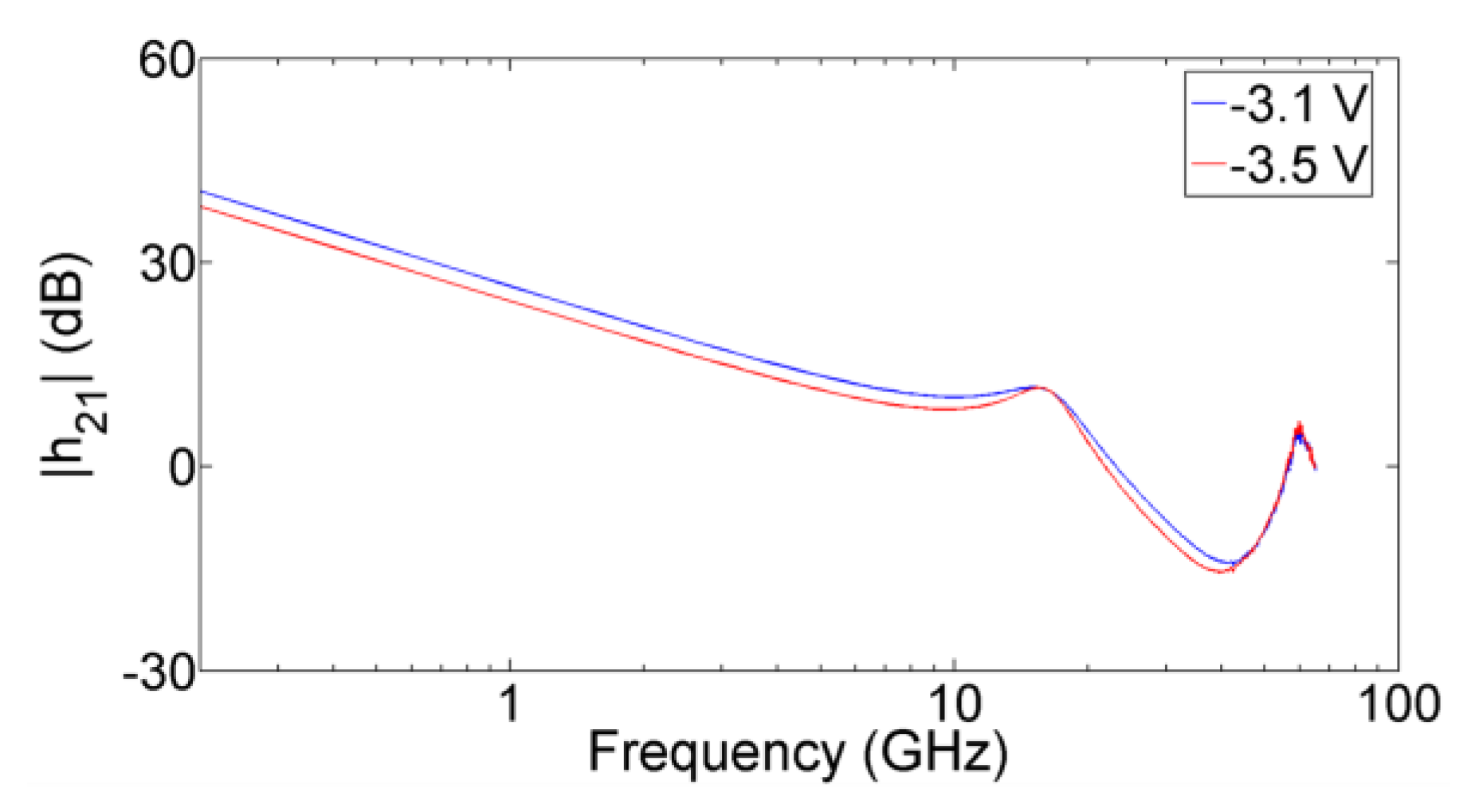
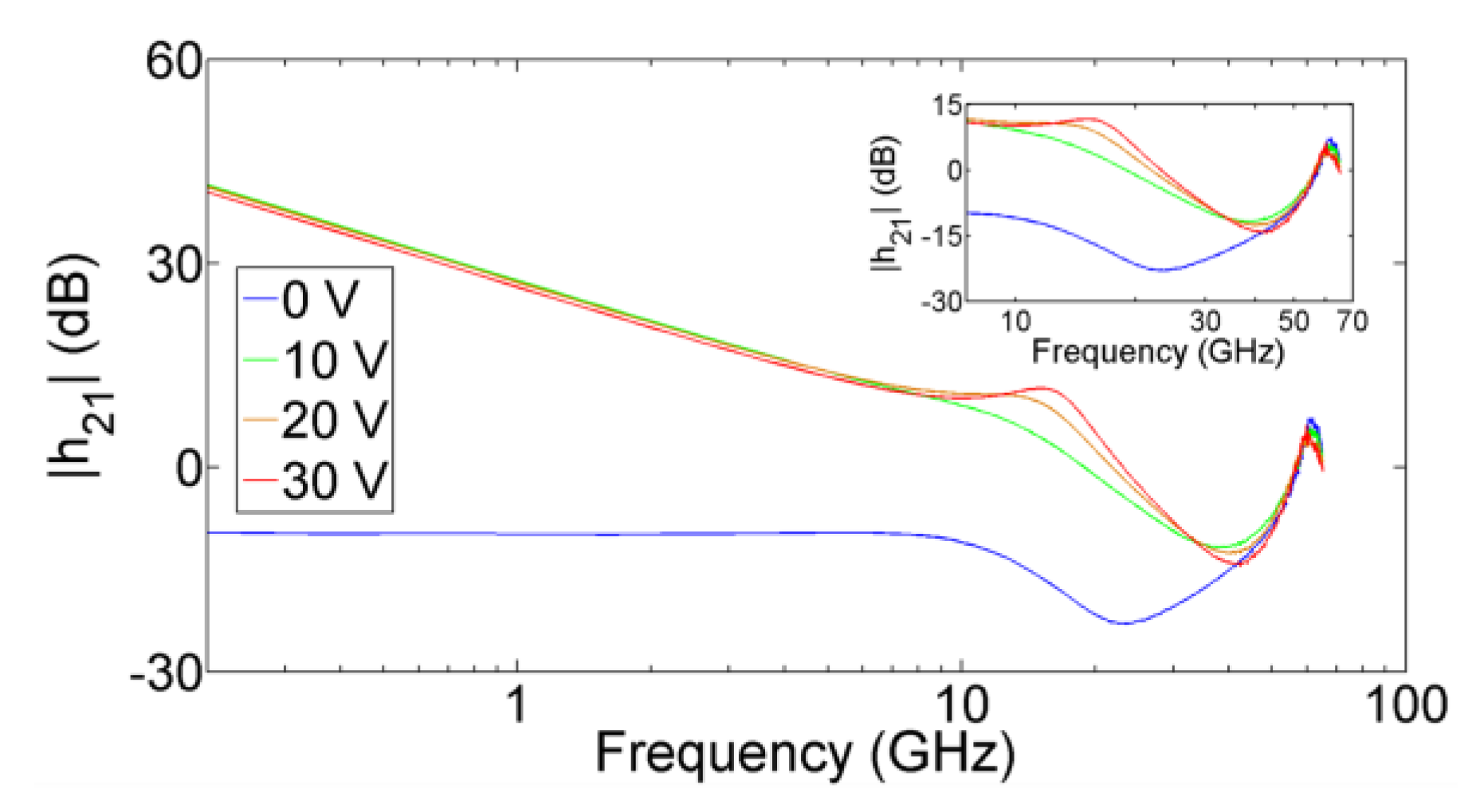


© 2018 by the authors. Licensee MDPI, Basel, Switzerland. This article is an open access article distributed under the terms and conditions of the Creative Commons Attribution (CC BY) license (http://creativecommons.org/licenses/by/4.0/).
Share and Cite
Crupi, G.; Raffo, A.; Vadalà, V.; Vannini, G.; Caddemi, A. A New Study on the Temperature and Bias Dependence of the Kink Effects in S22 and h21 for the GaN HEMT Technology. Electronics 2018, 7, 353. https://doi.org/10.3390/electronics7120353
Crupi G, Raffo A, Vadalà V, Vannini G, Caddemi A. A New Study on the Temperature and Bias Dependence of the Kink Effects in S22 and h21 for the GaN HEMT Technology. Electronics. 2018; 7(12):353. https://doi.org/10.3390/electronics7120353
Chicago/Turabian StyleCrupi, Giovanni, Antonio Raffo, Valeria Vadalà, Giorgio Vannini, and Alina Caddemi. 2018. "A New Study on the Temperature and Bias Dependence of the Kink Effects in S22 and h21 for the GaN HEMT Technology" Electronics 7, no. 12: 353. https://doi.org/10.3390/electronics7120353
APA StyleCrupi, G., Raffo, A., Vadalà, V., Vannini, G., & Caddemi, A. (2018). A New Study on the Temperature and Bias Dependence of the Kink Effects in S22 and h21 for the GaN HEMT Technology. Electronics, 7(12), 353. https://doi.org/10.3390/electronics7120353








